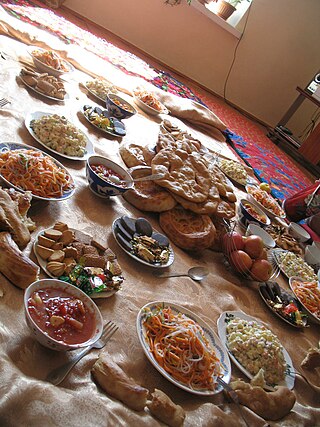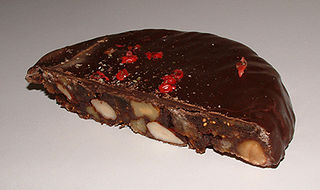
Dessert is a course that concludes a meal. The course consists of sweet foods, such as cake, biscuit, ice cream and possibly a beverage such as dessert wine and liqueur. Some cultures sweeten foods that are more commonly savory to create desserts. In some parts of the world there is no tradition of a dessert course to conclude a meal.
Albanian cuisine is a representative of the cuisine of the Mediterranean. It is also an example of the Mediterranean diet based on the importance of olive oil, fruits, vegetables and fish. The cooking traditions of the Albanian people are diverse in consequence of the environmental factors that are more importantly suitable for the cultivation of nearly every kind of herbs, vegetables and fruits. Olive oil is the most ancient and commonly used vegetable fat in Albanian cooking, produced since antiquity throughout the country particularly along the coasts.

Fruitcake or fruit cake is a cake made with candied or dried fruit, nuts, and spices, and optionally soaked in spirits. In the United Kingdom, certain rich versions may be iced and decorated.

Arab cuisine is the cuisine of the Arab world, defined as the various regional cuisines of the Arab people, spanning from the Maghreb to the Mashriq. These cuisines are centuries old and reflect the culture of trading in ingredients, spices, herbs, and commodities. The regions have many similarities, but also unique traditions. They have also been influenced by climate, cultivation, and mutual commerce.

In many European countries, particularly in Central and Eastern Europe, there are various traditions surrounding the use of bread during the Easter holidays. Traditionally the practice of eating Easter bread or sweetened "communion" bread traces its origin back to Byzantium, Eastern Catholicism and the Orthodox Christian church. The recipe for sweetened or "honey-leavened" bread may date back as far as the Homeric Greek period based on anecdotal evidence from classical texts.

Sindhi cuisine refers to the distinct native cuisine of the Sindhi people from Sindh, Pakistan. Sindhi cuisine has been influenced by Central Asian, Iranian, Mughal food traditions. It is mostly a non-vegetarian cuisine, with even Sindhi Hindus widely accepting of meat consumption. The daily food in most Sindhi households consists of wheat-based flat-bread (Mani) or rice accompanied by two dishes, one gravy and one dry with curd, papad or pickle. Freshwater fish and a wide variety of vegetables are usually used in Sindhi cuisine. Restaurants specializing in Sindhi cuisine are rare, although it is found at truck stops in rural areas of Sindh province, and in a few restaurants in urban Sindh.

Central Asian cuisine has been influenced by Persian, Indian, Arab, Turkish, Chinese, Mongol, African and Russian cultures, as well as the culinary traditions of other varied nomadic and sedentary civilizations. Contributing to the culinary diversity were the migrations of Uyghur, Slav, Korean, Tatar, Dungan and German people to the region.
Armenian cuisine includes the foods and cooking techniques of the Armenian people and traditional Armenian foods and drinks. The cuisine reflects the history and geography where Armenians have lived and where Armenian empires existed. The cuisine also reflects the traditional crops and animals grown and raised in Armenian-populated or controlled areas.

Cinnamon sugar is a mixture of ground cinnamon and granulated sugar used as a spice to flavor foods such as Belgian waffles, Snickerdoodle cookies, tortillas, coffee cake, French toast, and churros. It is also used to flavor apples, cereals, and other fruits. As McCormick describes cinnamon sugar, "it’s the comforting scent of Sunday morning cinnamon toast and mid-summer’s peach cobbler...the aroma of the holidays, with cinnamon cookies and spice cake."

Palestinian cuisine consists of foods from or commonly eaten by Palestinians, whether in Palestine, Israel, Jordan, or refugee camps in nearby countries, or by the Palestinian diaspora. The cuisine is a diffusion of the cultures of civilizations that settled in the region of Palestine, particularly during and after the Islamic era beginning with the Arab Ummayad conquest, then the eventual Persian-influenced Abbasids and ending with the strong influences of Turkish cuisine, resulting from the coming of the Ottoman Turks. It is similar to other Levantine cuisines, including Lebanese, Syrian and Jordanian.

Israeli cuisine primarily comprises dishes brought from the Jewish diaspora, and has more recently been defined by the development of a notable fusion cuisine characterized by the mixing of Jewish cuisine and Arab cuisine. It also blends together the culinary traditions of the various diaspora groups, namely those of Middle Eastern Jews with roots in Southwest Asia and North Africa, Sephardi Jews from Iberia, and Ashkenazi Jews from Central and Eastern Europe.

The cuisine of Algeria is influenced by Algeria's interactions and exchanges with other cultures and nations over the centuries. It is based on both land and sea products. Conquests or demographic movement towards the Algerian territory were two of the main factors of exchanges between the different peoples and cultures. The Algerian cuisine is a mix of Arab, Berber, Turkish and French roots.

Panpepato or pampepato is a round, sweet cake typical of the province of Ferrara, Siena, the south Umbria and north of Lazio also called "pangiallo". Panpepato is a type of panforte. It is made according to traditional methods from various ingredients including fruits and nuts, such as almonds, hazelnuts, pine nuts, walnuts, pepper, cinnamon, nutmeg, and zest of orange and lime, mixed according to the variants with or without cocoa, honey, flour, or cooked grape must. The cake is then baked in an oven. After baking, it is covered with a layer of chocolate. It is usually eaten during the Christmas holidays. Once it was prepared in every family with recipes that differed slightly from each other, while today it is essentially a handmade product.

Christmas in Italy begins on 8 December, with the Feast of the Immaculate Conception, the day on which traditionally the Christmas tree is mounted and ends on 6 January, of the following year with the Epiphany, and in some areas female puppets are burned on a pyre, to symbolize, along with the end of the Christmas period, the death of the old year and the beginning of a new one. 26 December, is also a public holiday in Italy. The Italian term Natale derives from the Latin natalis, which literally means 'birth', and the greetings in Italian are buon Natale and felice Natale.

The cuisine of Basilicata, or Lucanian cuisine, is the cuisine of the Basilicata region of Italy. It is mainly based on the use of pork and sheep meat, legumes, cereals and vegetables, with the addition of aromas such as hot peppers, powdered raw peppers and horseradish. The local gastronomy is, for historical-cultural reasons, typically peasant, based on simple recipes and on the culture of reuse, in particular of meat and bread.















